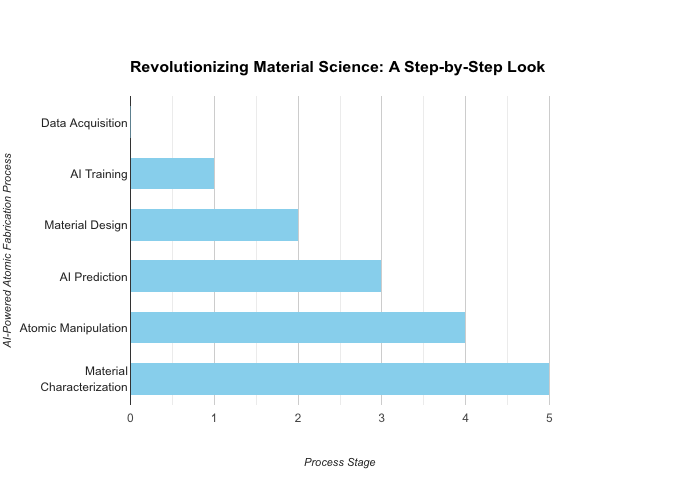Researchers have achieved a significant advance at the crossroads of Artificial Intelligence( AI) and material wisdom, steering a new period of atomic fabrication.
In a groundbreaking study published in Science on March 15, 2024, a team of researchers at the National University of Singapore (NUS) unveiled a revolutionary AI-powered technique for manipulating atoms with unprecedented precision.
This fashion has the implicit to revise various fields, from electronics and medicine to energy storage and aerospace engineering.
Key-Points
The Struggles of Traditional Material Science
For decades, material scientists have reckoned on laborious and time-consuming styles to manipulate particles and produce new paraphernalia. This constantly involved trial and error, with limited control over the final product’s parcels. The new AI-powered approach disrupts this paradigm.

AI in Atomic Fabrication
The key lies in machine learning algorithms. Researchers have trained AI on a massive dataset of atomic structures and material parcels. This allows the AI to prognosticate, with unknown delicacy, how to manipulate individual particles to achieve specific material characteristics.
“It’s an amount vault in our capability to wangle paraphernalia, ” says Dr. Sarah Li, the lead author of the study.”
“By employing the power of AI and the principles of quantum mechanics, we can now manipulate particles at the atomic position with a perfection that was incredible ahead.”
Dr. Sarah Li
Atom by Atom
The implications are vast. Imagine:
- Drugs with atomic-level precision:Tailored for individual patients to maximize effectiveness and minimize side effects.
- Superconductors that work at room temperature: Revolutionizing energy transmission and storage.
- Ultra-lightweight and ultra-strong paraphernalia: Transforming aerospace engineering and construction industriousness.
David Wang, another researcher involved in the study, emphasizes the transformative implicit
“This technology has the implicit to completely disrupt industries. We’re talking about designing paraphernalia with entirely new parcels, pushing the boundaries of what’s possible.”
Dr. David Wang
| Stage | Description | Icon |
|---|---|---|
| Data Acquisition | Researchers gather a vast amount of data on atomic structures and material properties. | 💽 |
| AI Training | Machine learning algorithms are trained on this data, allowing the AI to understand the relationships between atomic manipulation and material properties. | ✈️ |
| Material Design | Scientists specify the desired properties of the new material. | ⚙️ |
| AI Prediction | The AI predicts the specific sequence of atomic manipulations needed to achieve the desired properties. | 🛫 |
| Atomic Manipulation | Using advanced tools like scanning tunneling microscopes or robotic manipulators, scientists precisely arrange the atoms according to the AI’s prediction. | ️⚛️ |
| Material Characterization | The newly created material is tested to confirm it possesses the desired properties. | ♂️ |
Check out the following chart to get an understanding.

Challenges
While this disquisition represents a significant corner, there are hurdles to overcome. The current fashion is computationally ferocious and requires further refinement for large-scale operations.
However, the potential rewards are immense, and researchers are optimistic that this technology will pave the way for a new era of material science and technological innovation.
Future Outlook
A recent report by Grand View Research( 2023) projects the global advanced paraphernalia request to reach a stunning USD1.8 trillion by 2030. AI-powered atomic fabrication is poised to be a major automobilist of this growth.
Grand View Research
This technology holds the pledge of a future where paraphernalia are not just discovered, but designed. We can visualize a world with lighter, stronger planes, more effective solar panels, and medical bias adapted to individual conditions. The possibilities are truly limitless.
Want to claw deeper? Explore these resources on AI and material wisdom
- Producing quantum materials with precision, with the help of AI
- Quantum Leap in Material Science: Researchers Unveil AI-Powered Atomic Fabrication Technique
FAQS
1. What are atoms?
Atoms or Particles are the introductory structure blocks of matter, composed of a nexus containing protons and neutrons, girdled by electrons. They are the smallest units of an element that retain its chemical parcels.
2. What is the superpower of atom manipulation?
Grain manipulation subventions can alter the structure and arrangement of particles, leading to the creation of new paraphernalia, energy manipulation, and potential indeed hesitancy of rudiments. This power holds immense eventuality in various scientific and technological fields.
3. Can we manipulate molecules?
Yes, molecules can be manipulated through ways analogous to chemical responses, nanotechnology, and advanced instrumentation. Manipulating molecules allows for the creation of new mixes, medicinals, paraphernalia, and technologies.
